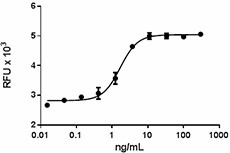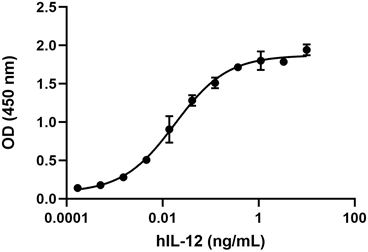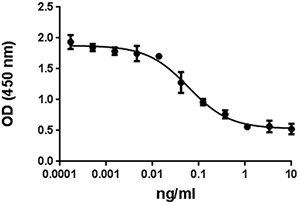- Regulatory Status
- RUO
- Other Names
- TNFSF14, tumor necrosis factor (TNF) superfamily member 14, Herpesvirus entry mediator ligand (HVEML), CD258.
- Ave. Rating
- Submit a Review
- Product Citations
- publications

-

Recombinant human Light induces proliferation of HUVEC in a dose dependent manner with ED50 = 1.5 - 6 ng/mL.
| Cat # | Size | Price | Save |
|---|---|---|---|
| 762402 | 10 µg | ¥29,260 | |
| 762404 | 25 µg | ¥50,350 |
LIGHT is a member of the TNF family which includes TNF-α, TNF-β (lymphotoxin-alpha, LT-α), CD40 ligand, TRAIL (Apo2L), Fas ligand (FASL), and osteoprotegerin (OPG) ligand. LIGHT is a type II transmembrane protein that possesses 34% identity with lymphotoxin beta (LT-β), and shares a 31% identity with FASL. LIGHT stimulates the proliferation of activated HVEM+ T-cells, NF-κB activation, and induces apoptosis in cells expressing both HVEM+ and LT-β receptors. B- and T- lymphocyte attenuators (BTLA) also bind to HVEM. LIGHT, as well as other members of the TNF/TNFR family, is released from the membrane by MMPs. It plays a key role for optimal IL-12 production by the dendritic cells (DCs) and the development of IFN-γ-producing CD4+ Th1 cells. Bone marrow-derived DCs from LIGHT (-/-) mice are severely impaired in IL-12p40 production after IFN-γ and LPS stimulation in vitro. LIGHT is expressed in lung inflammatory leukocytes after an allergen house dust mite challenge. It induces airway remodeling via the induction of TGF-β. The inhibition of LIGHT, using a fusion protein of Fc with the extracellular portion of the LT-β receptor (LTβ R-Fc), prevents LIGHT-LTβ R and LIGHT-HVEM interaction. In a mouse model of chronic asthma, this reduces lung fibrosis, smooth muscle and epithelial hyperplasia, and airway hyper-responsiveness through the suppression of lung TGF-β and IL-13 production. LIGHT has been shown to increase the anti-tumor immune response and its overexpression is associated with the survival in patients with colorectal cancer liver metastasis.
Product DetailsProduct Details
- Source
- Human Light, amino acids (Asp74-Val240) (Accession# O43557), with N-terminal His tag was expressed in 293E cells.
- Molecular Mass
- The 188 amino acid recombinant protein has a predicted molecular mass of approximately 20.4 kD. The protein migrates at approximately 26 kD in both DTT-reducing conditions and non-reducing conditions by SDS-PAGE. The predicted N-terminal amino acid is His.
- Purity
- >95%, as determined by Coomassie stained SDS-PAGE.
- Formulation
- 0.22 µm filtered protein solution in PBS, pH 7.2.
- Endotoxin Level
- Less than 1.0 EU per µg protein as determined by the LAL method.
- Concentration
- 10-25 µg sizes are bottled at 100 µg/mL.
- Storage & Handling
- Unopened vial can be stored between 2°C and 8°C for up to 2 weeks, at -20°C for up to six months, or at -70°C or colder until the expiration date. For maximum results, quick spin vial prior to opening. The protein can be aliquoted and stored at -20°C or colder. Stock solutions can also be prepared at 50 - 100 µg/mL in appropriate sterile buffer, carrier protein such as 0.2 - 1% BSA or HSA can be added when preparing the stock solution. Aliquots can be stored between 2°C and 8°C for up to one week and stored at -20°C or colder for up to 3 months. Avoid repeated freeze/thaw cycles.
- Activity
- ED50 = 1.5 - 6 ng/mL, as measured by the ability of the protein to induce proliferation of HUVEC.
- Application
-
Bioassay
- Application Notes
-
BioLegend carrier-free recombinant proteins provided in liquid format are shipped on blue-ice. Our comparison testing data indicates that when handled and stored as recommended, the liquid format has equal or better stability and shelf-life compared to commercially available lyophilized proteins after reconstitution. Our liquid proteins are verified in-house to maintain activity after shipping on blue ice and are backed by our 100% satisfaction guarantee. If you have any concerns, contact us at tech@biolegend.com.
Antigen Details
- Structure
- Homotrimer.
- Distribution
-
Intestinal mucose T and NK cells, gut-homing CD4+ T cells, B cells, CD4 and CD8 lymphocytes.
- Function
- Enhances inflammation and T cell-mediated immunity, stimulates the proliferation of activated T cells. Homologous to lymphotoxins, it exhibits inducible expression and competes with HSV glycoprotein D for HVEM, which is a receptor expressed by T lymphocytes.
- Interaction
- T cells, B cells, NK cells, eosinophils, macrophages, and bronchial epithelial cells.
- Ligand/Receptor
- TNFRSF14/HVEM and LTβR, decoy receptor DCr3/TR6.
- Bioactivity
- Measured by its ability to induce proliferation of HUVEC.
- Biology Area
- Cell Biology, Immunology
- Molecular Family
- CD Molecules, Cytokines/Chemokines, Growth Factors
- Antigen References
-
1. Harrop JA, et al. 1998. J. Biol. Chem. 273:27548.
2. Wan X, et al. 2002. J. Immunol. 169:6813.
3. Xu G, et al. 2007. J. Immunol. 179:6901.
4. Doherty TA, et al. 2011. Nat. Med. 17:596.
5. Qin JZ, et al. 2013. J. Transl. Med. 11:70.
6. Qiu HN, et al. 2014. Mediators Inflamm. 2014:136463. - Gene ID
- 8740 View all products for this Gene ID
- UniProt
- View information about Light on UniProt.org
Related FAQs
- Why choose BioLegend recombinant proteins?
-
• Each lot of product is quality-tested for bioactivity as indicated on the data sheet.
• Greater than 95% Purity or higher, tested on every lot of product.
• 100% Satisfaction Guarantee for quality performance, stability, and consistency.
• Ready-to-use liquid format saves time and reduces challenges associated with reconstitution.
• Bulk and customization available. Contact us.
• Learn more about our Recombinant Proteins. - How does the activity of your recombinant proteins compare to competitors?
-
We quality control each and every lot of recombinant protein. Not only do we check its bioactivity, but we also compare it against other commercially available recombinant proteins. We make sure each recombinant protein’s activity is at least as good as or better than the competition’s. In order to provide you with the best possible product, we ensure that our testing process is rigorous and thorough. If you’re curious and eager to make the switch to BioLegend recombinants, contact your sales representative today!
- What is the specific activity or ED50 of my recombinant protein?
-
The specific activity range of the protein is indicated on the product datasheets. Because the exact activity values on a per unit basis can largely fluctuate depending on a number of factors, including the nature of the assay, cell density, age of cells/passage number, culture media used, and end user technique, the specific activity is best defined as a range and we guarantee the specific activity of all our lots will be within the range indicated on the datasheet. Please note this only applies to recombinants labeled for use in bioassays. ELISA standard recombinant proteins are not recommended for bioassay usage as they are not tested for these applications.
- Have your recombinants been tested for stability?
-
Our testing shows that the recombinant proteins are able to withstand room temperature for a week without losing activity. In addition the recombinant proteins were also found to withstand four cycles of freeze and thaw without losing activity.
- Does specific activity of a recombinant protein vary between lots?
-
Specific activity will vary for each lot and for the type of experiment that is done to validate it, but all passed lots will have activity within the established ED50 range for the product and we guarantee that our products will have lot-to-lot consistency. Please conduct an experiment-specific validation to find the optimal ED50 for your system.
- How do you convert activity as an ED50 in ng/ml to a specific activity in Units/mg?
-
Use formula Specific activity (Units/mg) = 10^6/ ED50 (ng/mL)












Follow Us